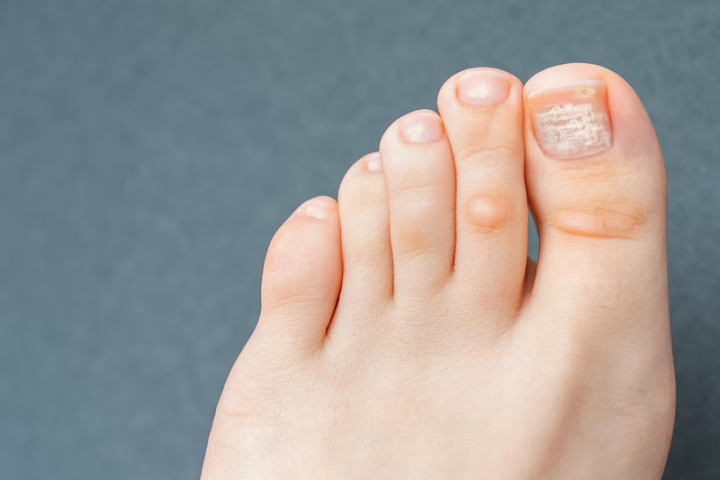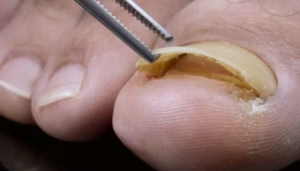Have you ever noticed white marks on your toenails or fingernails and wondered what they mean? You’re not alone. Many people spot small white dots, lines, or cloudy patches and assume it’s a sign of calcium deficiency or poor diet. But in most cases, those marks have a very different cause — and understanding what’s behind them can help you keep your nails healthy and strong.
In this article, we’ll explain the common causes of white marks on nails, when they’re nothing to worry about, and when you should see a podiatrist for professional assessment and treatment.
What Are White Marks on Nails?
White marks on nails — medically called leukonychia — are changes in the nail plate that make part or all of the nail appear white. These marks can look different depending on the cause:
- Small white spots or dots: usually appear after mild trauma to the nail.
- White streaks or bands: may indicate an ongoing irritation or systemic cause.
- Entire nail turning white or opaque: can be linked to underlying nail conditions or infections.
Although white marks can occur on both fingernails and toenails, toenails are more likely to develop them due to repeated micro-trauma, tight footwear, or fungal infections.
Common Causes of White Marks on Nails
1. Minor Nail Trauma
One of the most common reasons for white marks on nails is minor trauma. Bumping, pressure from shoes, or aggressive nail cutting can damage the nail matrix (the area where new nail cells form). This injury interrupts normal nail growth, leaving behind a small white dot or line that slowly grows out with the nail.
In athletes, runners, and people who wear snug footwear, this type of trauma is especially common on the toenails.
2. Fungal Nail Infection (Onychomycosis)
A fungal infection is another frequent cause of white marks or discolouration. In early stages, the infection may appear as white or chalky patches on the surface of the nail. As it progresses, nails can become thickened, crumbly, yellowish, or brittle.
Fungal infections thrive in warm, moist environments, making feet an ideal home for fungal spores. Podiatrists can diagnose fungal nail infections through visual examination or laboratory testing, and treat them with topical or oral antifungal medications.
3. Allergic Reaction or Chemical Exposure
Nail polish, acetone, cleaning products, and some adhesives can trigger mild allergic reactions that cause white patches or roughness on the nail surface. Overuse of harsh nail treatments or gel polish removers can also dehydrate and damage the keratin layer of the nail, leading to white marks.
If you notice white spots after a manicure or pedicure, consider switching to gentler, hypoallergenic products or taking a break from nail polish.
4. Nutrient Deficiencies (Rarely)
While it’s a common myth that white marks mean calcium or zinc deficiency, this is rarely the case. Nutrient-related nail changes typically affect the entire nail appearance (such as ridges or thinning) rather than causing isolated white marks. However, a balanced diet rich in protein, vitamins, and minerals supports overall nail health.
5. Systemic or Skin Conditions
Occasionally, white marks on nails can be linked to systemic health issues or skin disorders, such as:
- Psoriasis or eczema affecting the nail bed
- Kidney or liver disease (in rare cases, causing entire nails to turn white)
- Chronic infections or inflammatory conditions
If several nails are affected or you notice other symptoms like fatigue, jaundice, or swelling, a medical assessment is important.
When Should You See a Podiatrist?
While small white marks often grow out on their own, you should see a podiatrist if:
- The white marks are spreading or recurring
- The nails are thick, brittle, or discoloured
- You experience pain, odour, or separation of the nail from the nail bed
- You suspect a fungal infection
- You have diabetes or circulation issues that affect foot health
At ModPod Podiatry, our podiatrists can examine your nails, identify the exact cause, and recommend targeted treatment. Early diagnosis of fungal infections or other nail disorders prevents further damage and helps restore healthy nails faster.
How Podiatrists Diagnose and Treat White Marks on Nails
Diagnosis typically involves a visual nail assessment and, when necessary, a nail scraping or culture to confirm fungal infection. Treatment depends on the underlying cause:
- For trauma: trimming and protecting the nail to prevent further damage
- For fungal infection: topical antifungal lacquers, laser therapy, or prescribed oral medication
- For allergies or dryness: hydration treatments, nail conditioning oils, and avoiding harsh products
- For systemic issues: referral to your GP or specialist for further testing
Our team focuses on both the cause and prevention, ensuring long-term improvement and healthier nail regrowth.
Preventing White Marks on Toenails
Simple preventive steps can make a big difference:
- Wear properly fitted shoes to reduce pressure and friction.
- Keep feet clean and dry to prevent fungal growth.
- Trim nails straight across — avoid cutting too short or digging into corners.
- Use breathable socks made from natural fibres.
- Avoid over-buffing or harsh chemicals on your nails.
- Disinfect nail tools regularly, especially after pedicures.
Maintaining good nail hygiene and seeing a podiatrist early at the first sign of change can prevent minor issues from becoming long-term problems.
The Bottom Line
Most white marks on nails are harmless and caused by minor trauma or mild irritation, but sometimes they signal a fungal infection or underlying health issue that requires attention.
If you’re unsure about what’s causing the white marks on your toenails, or if the problem persists, the podiatry team at ModPod Podiatry can help. We specialise in nail health, fungal treatment, and preventative foot care across Sydney and can tailor a treatment plan to get your nails back to their best.
Book an appointment with ModPod Podiatry today to have your nail health professionally assessed. Don’t ignore those little white marks — they may be your body’s way of asking for care.



